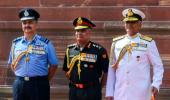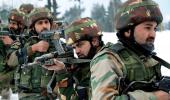As violent protests against the new recruitment scheme Agnipath raged across several states, the government on Thursday issued a clarification, asserting that not only the new model will bring in new capabilities to the armed forces but will also open up avenues for youth in the private sector as well as help them in becoming entrepreneurs with the aid of the financial package.

Apart from issuing a 'Myth vs Facts' document to address the concerns raised on the scheme, the government's information dissemination arm issued a series of social media posts, saying in the coming years, recruitment of Agniveers will be around triple the current recruitment in armed forces and ruled out any change to the regimental system.
'The scheme will bring in new dynamism to the armed forces. It will help the forces bring in new capabilities and take advantage of the technical skills and fresh thinking of the youths... It will allow the youths to serve the nation,' the Press Information Bureau said in a Facebook post.
Referring to the financial package of around Rs 11.71 lakh to be given to each of the recruits at the end of the four-year tenure from the 'Seva Nidhi Package', it said it will provide financial independence to the youths and even help them to venture into entrepreneurship.
The clarification came in the wake of protests in several states, including Bihar, Uttar Pradesh and Haryana.
Trains were set afire, window panes of buses smashed and passersby, including a ruling Bharatiya Janata Party MLA, pelted with stones in Bihar by Army job aspirants whose protest against the Central scheme continued for the second consecutive day.
The opposition also stepped up its attack against the government with Congress leader Rahul Gandhi urging Prime Minister Narendra Modi to listen to the voice of unemployed youths and not take 'agnipareeksha (trial by fire)' of their patience by making them walk on Agnipath, Samajwadi Party president Akhilesh Yadav called the move 'negligent' and potentially 'fatal' for the country's future.
Some military veterans have also slammed the scheme saying it will adversely impact the functioning of the armed forces.
The government officials also strongly rejected criticism that 'Agniveers' could be a danger to society after their exit from the armed forces.
"This is an insult to the ethos and values of the Indian armed forces. Youngsters who have worn the uniform for four years will remain committed to the country for the rest of their lives," said an official.
"Even now thousands retire from armed forces with skills, but there have not been any instance of them joining anti-national forces," the officer said.
Those to be recruited under the 'Agnipath' scheme will be known as 'Agniveers'.
The government on Tuesday unveiled the scheme for the recruitment of soldiers in the Army, Navy and the Air Force largely on a four-year short-term contractual basis, in a major overhaul of the decades-old selection process.
Under the scheme, youths between the ages of 17 and a half and 21 years will be inducted into the three services.
After completion of the four-year tenure, the scheme provides for retaining 25 per cent of the recruits for regular service.
After the scheme was rolled out, the Army said it would ensure an enhanced youthful profile of the force and result in a 'reduction in the average age from 32 to 26 years over a period of time'.
"For those wishing to be entrepreneurs -- they will get a financial package and bank loan scheme. For those wishing to study further -- they will be given a 12 class equivalent certificate and bridging course for further studies," said the official.
There were apprehensions that the 'Agnipath' scheme would change the composition of several regiments that recruit youths from specific regions as well as castes such as Rajputs, Jats and Sikhs.
"No change is being done to the regimental system. In fact, it will be further accentuated because the best of 'Agniveers' will be selected, further boosting the cohesiveness of the units," said another official.
On the criticism that the short-duration tenure of 'Agniveers' will harm the effectiveness of the armed forces, the officials said such a system exists in several countries, and hence, it is already tested out and considered best practice for an agile army.
The numbers of 'Agniveers' to be recruited in the first year would only make up three per cent of the armed forces, they said, adding their performance will be tested before re-induction into the army after four years.
"Hence Army will get tested and tried personnel for supervisory ranks," one of the officials said.
Officials said most armies across the world depend upon their youths and the new scheme will only bring about a right mix of '50 per cent of youth and 50 per cent of experience' in the long run in the supervisory ranks.
They said the scheme has been launched following extensive consultations with serving armed forces officers in the last two years.
The proposal has been framed by the Department of Military Officers staffed by military officers, they said.
Under the scheme, the Army is likely to recruit around 40,000 soldiers, the Navy is expected to induct around 3,000 sailors and the Indian Air Force is set to recruit 3,000 airmen this year.
Sources said the government plans to have a centralised database on the Agniveers to keep track of the skills that they would acquire during their four-year tenure.











 © 2025
© 2025